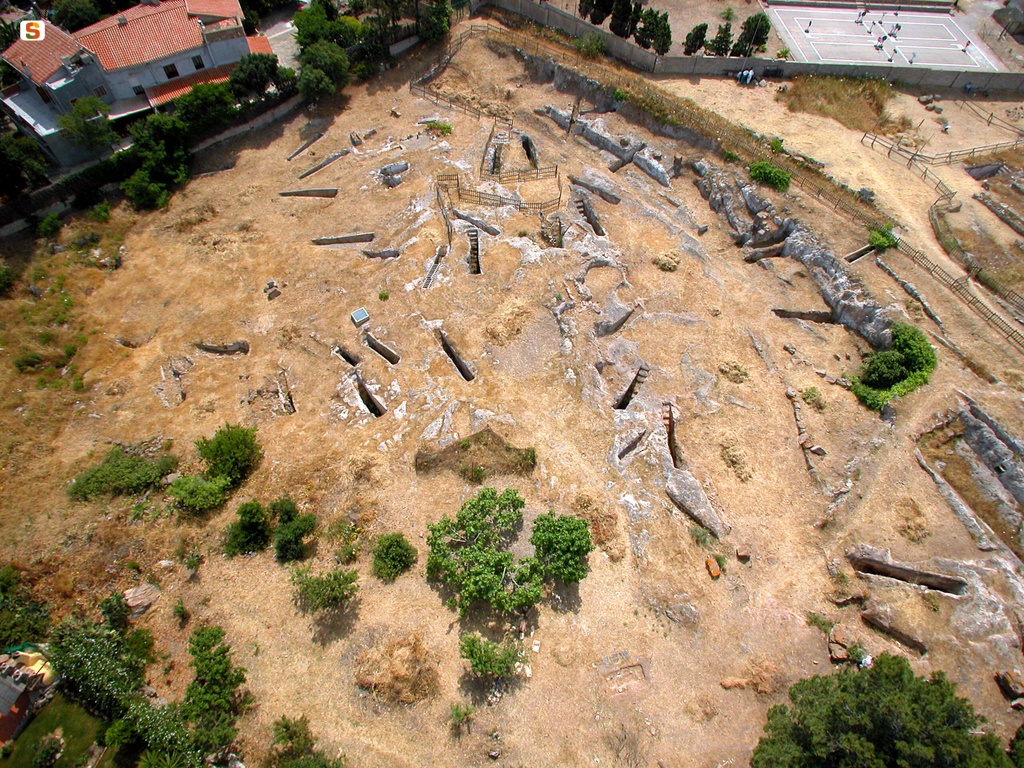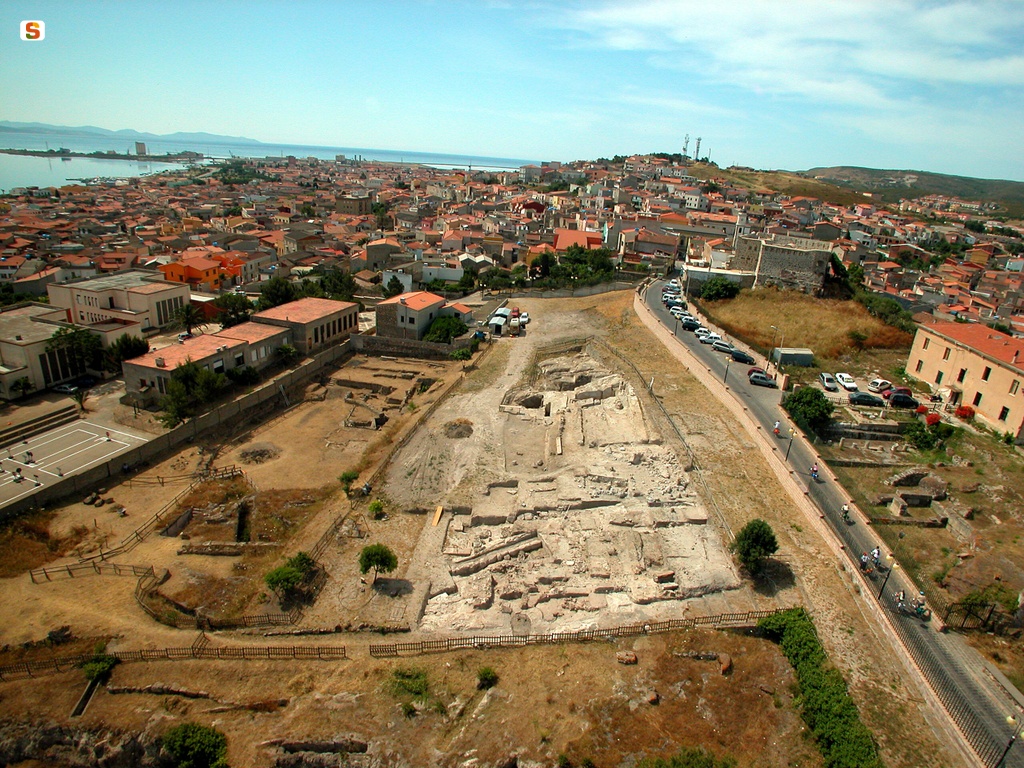Sulky was located in the place of today's Sant'Antioco, in the N/E part of the homonymous Sulcitan island, in S/W of Sardinia. You can visit the MAB F. Barreca Archaeological Museum, the Tofet, the Savoy fort, the underground village, the Ethnographic Museum, the Necropolis and the Acropolis.
The remains of the archaic settlement, discovered fortuitously in 1983 thanks to the renovation of the city's hospice, consist of an overlapping of rectangular and quadrangular rooms, according to a simple orthogonal pattern, oriented from E to W. These rooms are built with medium and small stones, tied with mud mortar, on which a brick rise in raw earth is set up, while the decking floors consist of paved earth and clay. One of these courtyards has returned a silo for foodstuffs, probably cereals, and a deep quadrangular-shaped tank whose upper part is covered with a layer of stones. In the same tank, a considerable quantity of ceramics have been found, referring to various periods, but for the most part attributable to the period from the 5th to the 3rd century BC. Archaic Phoenician ceramics, also oriental, present in considerable quantity at the various levels of life of
the town, associated with latdogeometric Greek pottery, make it possible to include Sulky as part of the first wave of Phoenician colonization in the West and to date the town to 770 BC, thanks also to the discovery of clearly Lebanese-made containers. Thesis.
The settlement of Sulky was penalized by the Carthaginian conquest of the island, even if, since the 4th century BC, there are numerous remains of the Punic Age that attest to its economic recovery and its renewed role as the capital of a large and densely populated region.
In the 4th century BC, the fortified city walls were developed, completed by some towers, a vestibule door with two monumental lions and a sort of fortress located in the Tofet area. The Tofet, located at the northern end of the town, in the town of Guardia de Is Pingiadas, is one of the most significant elements of continuity of life in the history of the ancient colony. In fact, the first structure of the sanctuary is linked to the first period of life of the settlement, with the discovery of single-sided pans of Phoenician workmanship but of Nuragic origin, a symptom of a peaceful integration of the Levantine people with local people.
As far as the necropolises are concerned, the Phoenician one can probably be located on the coast below the port area, while the Punic one is to be safely identified below the current town. The Punic necropolis of Sulky is currently one of the most important in the Mediterranean, with a very large number of tombs (about 1500), whose chronology goes from the first years of the 5th to the end of the 3rd century BC. The necropolis is dominated by underground chamber tombs, characteristic of the Punic period, even if there is no shortage of burials
in “enkytrismos”, that is, inside amphorae, reserved exclusively for children, and some rare examples of pit tombs covered with tuff slabs. The oldest tombs are located towards the church and the center of the town, as demonstrated by the recent discovery of a hypogeum from the early 5th century BC in Via Belvedere.
The numerous important Phoenician and Punic finds found in the excavations of the tofet, the necropolis and the town, as well as objects from the Roman age, are visible in the Municipal Archaeological Museum “Ferruccio Barreca”.
History of excavations
The first mentions of the antiquity and importance of the Sant'Antioco site date back to 1580, by Canon Giovanni Fara. After him, many other scholars, including Della Marmora and Lo Spano, became interested in the site. The first scientific archaeological excavation interventions were conducted by Antonio Taramelli, who in the period between 1903 and 1921 published with rigor and precision the report of his investigation activity. Subsequent interventions were conducted by Salvatore Puglisi, Paolo Mingazzini and Giovanni Lilliu. In 1956, systematic investigations began. Gennaro Pesce discovered the tofet in the town significantly known as “Sa Guardia de is Pingiadas” and extended the investigation to the Punic necropolis. Subsequent interventions, starting in 1967, were conducted by Ferruccio Barreca in the area of the Punic necropolis. At the end of the 80s, Piero Bartoloni, Paolo Bernardini and Carlo Tronchetti investigated an area of the first century A.D. settlement (Chronicle).
Bibliography
G. Spano, “Description of the ancient city of Sulcis, Site and extension”, in Sardinian Archaeological Bulletin, 3, 1857; P. Bartoloni-P. Bernardini-C. Tronchetti, “Saint Antiochus. Chronicle Area, excavation campaigns 1983-86", in Rivista di Studi Feniici, 16, 1988;
P. Bartoloni, Sulcis, series “Itineraries”, 3, Rome, Polygraphic Institute and State Mint, 1989; C. Tronchetti, S. Antioco.
Sassari, C. Delfino, 1989 (Archaeological Sardinia. Guides and itineraries; 12);
P. Bernardini, “S. Antioco (Cagliari), Phoenician settlement and Punic necropolis”, in Bulletin of Archaeology, 3, 1990;
P. Bartoloni, A pitiful funeral rite obfuscated by too many myths, “Darwin. Notebooks”, n. 1 (July-August 2006), pp. 68-75.
Structure category: archaeological area or park
Content type:
Archaeological complex
Archaeology
Usability: Open
Province: Sud Sardegna
Common: Sant'Antioco
Macro Territorial Area: South Sardinia
POSTAL CODE: 09017
Address: via Sabatino Moscati, 1
Telephone: +39 0781 82105 +39 389 7962114
E-mail: info@archeotur.it tofet@tiscali.it archeotur@tiscali.it
Website: mabsantantioco.it parcostoricoarcheologicosantantioco.it/tofet
Facebook: www.facebook.com/parcostoricoarcheologicodisantantioco
Information on tickets and access: It is possible to check the updated schedules and make reservations on the website of the Sant'Antioco historical archaeological park. Tickets are also available at the ticket offices of: F. Barreca Archaeological Museum via Sabatino Moscati, 1 - Ethnographic Museum via Necropoli, 24 D.
Access mode: For a fee
Update
Services
Bookshop
Audiooguide
Guided tours
Facilitated physical accessibility for visitors with specific needs
Where is it
Images


Results 2 of 111128
View AllTexts
Comments